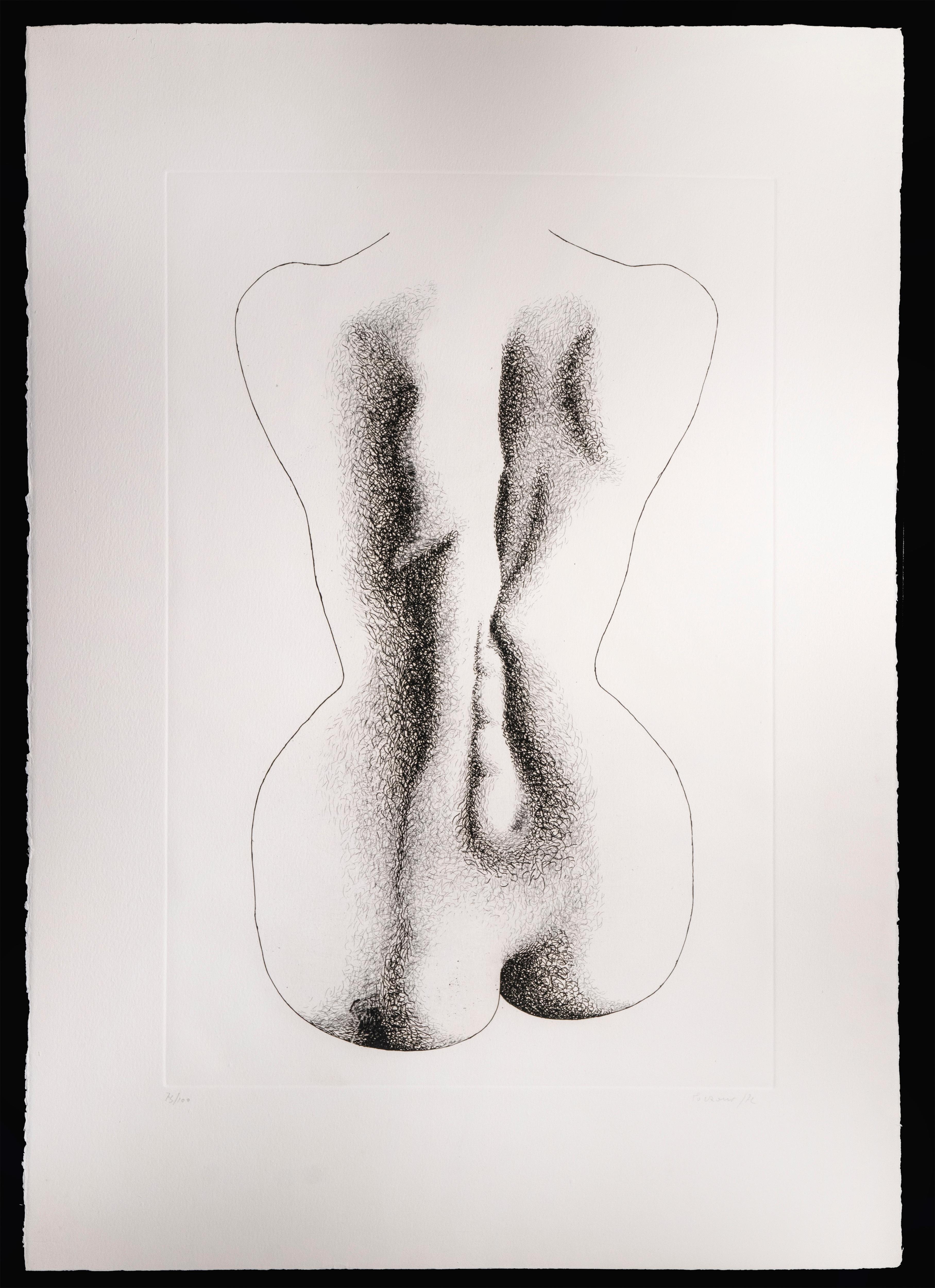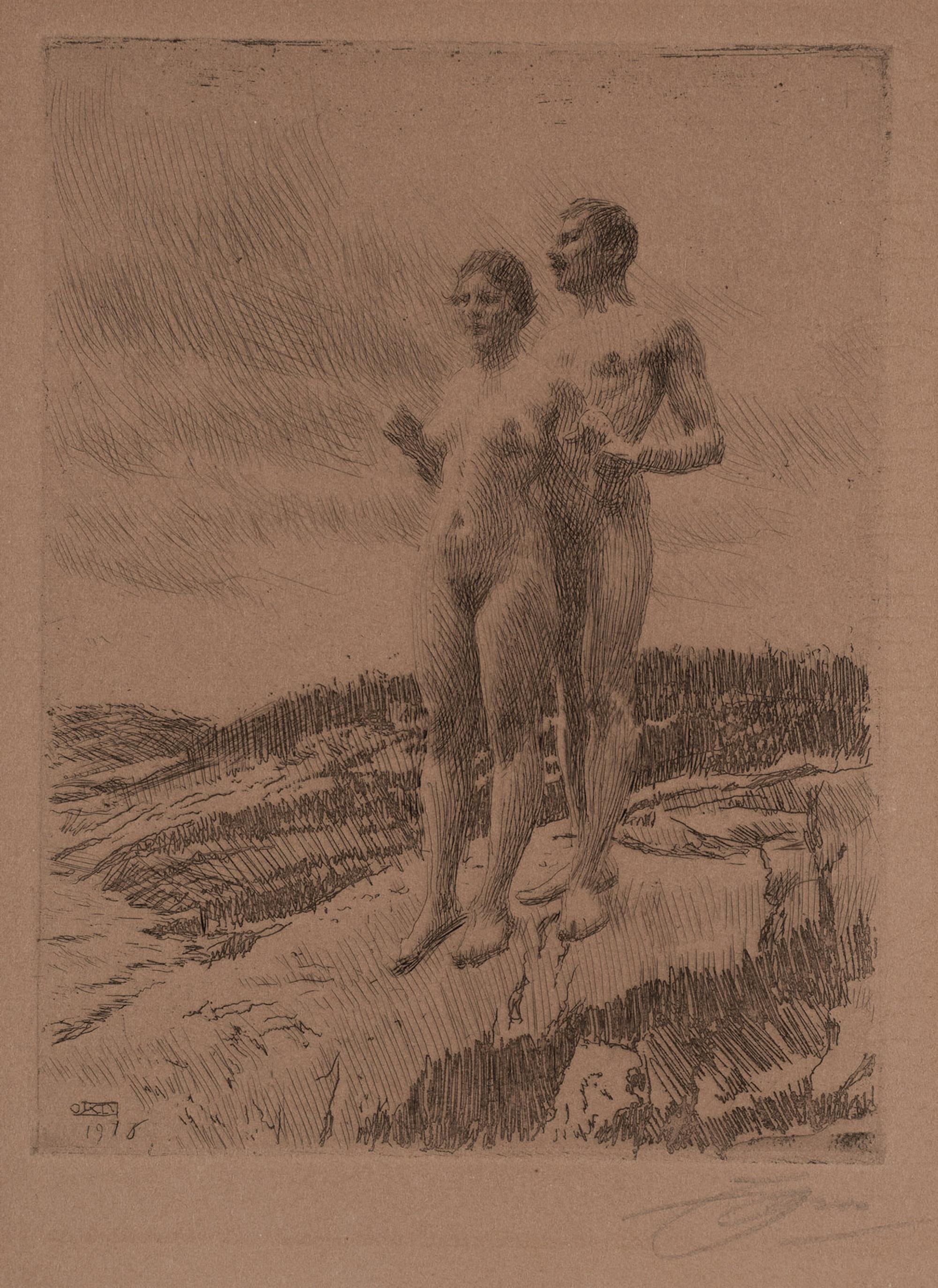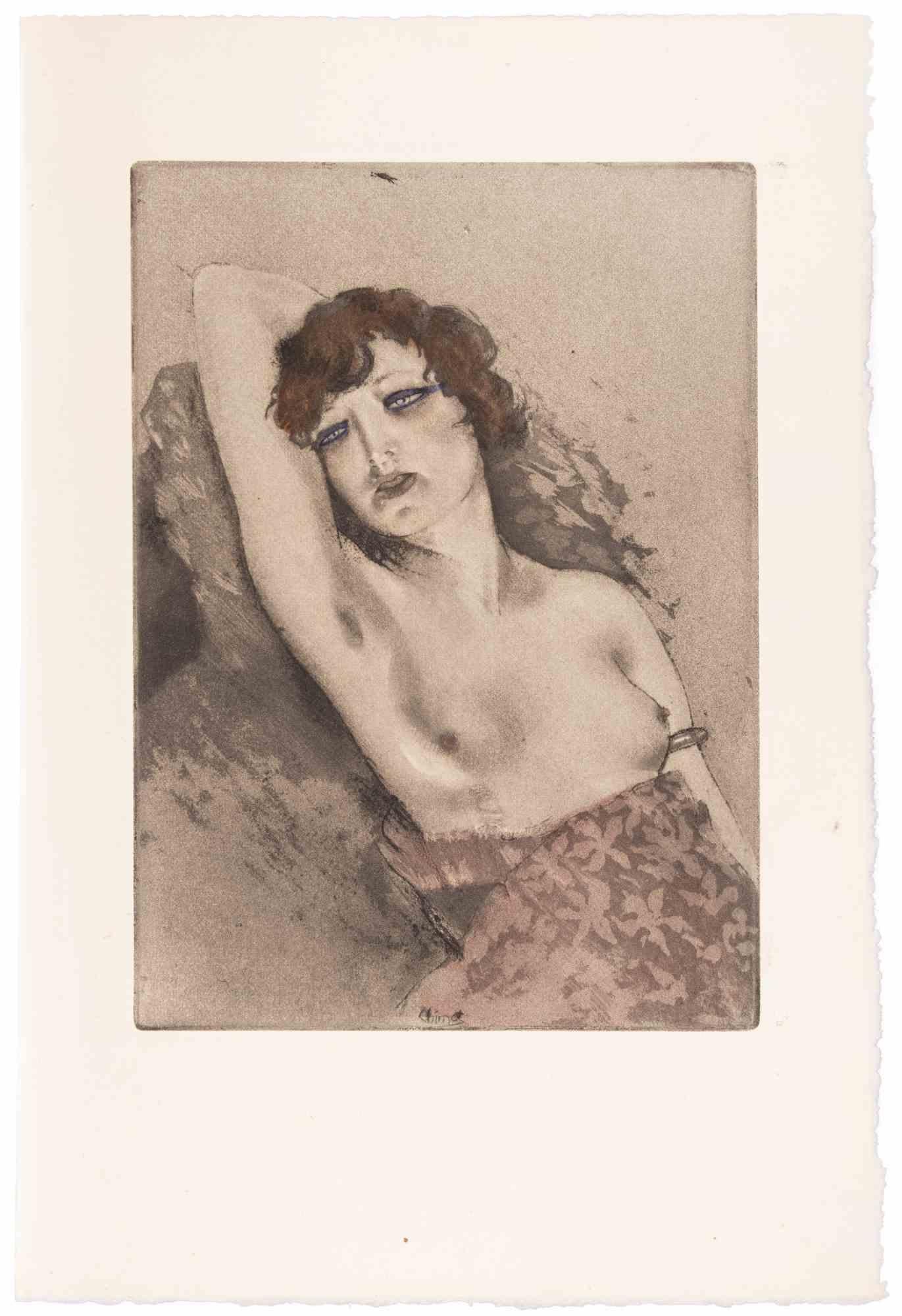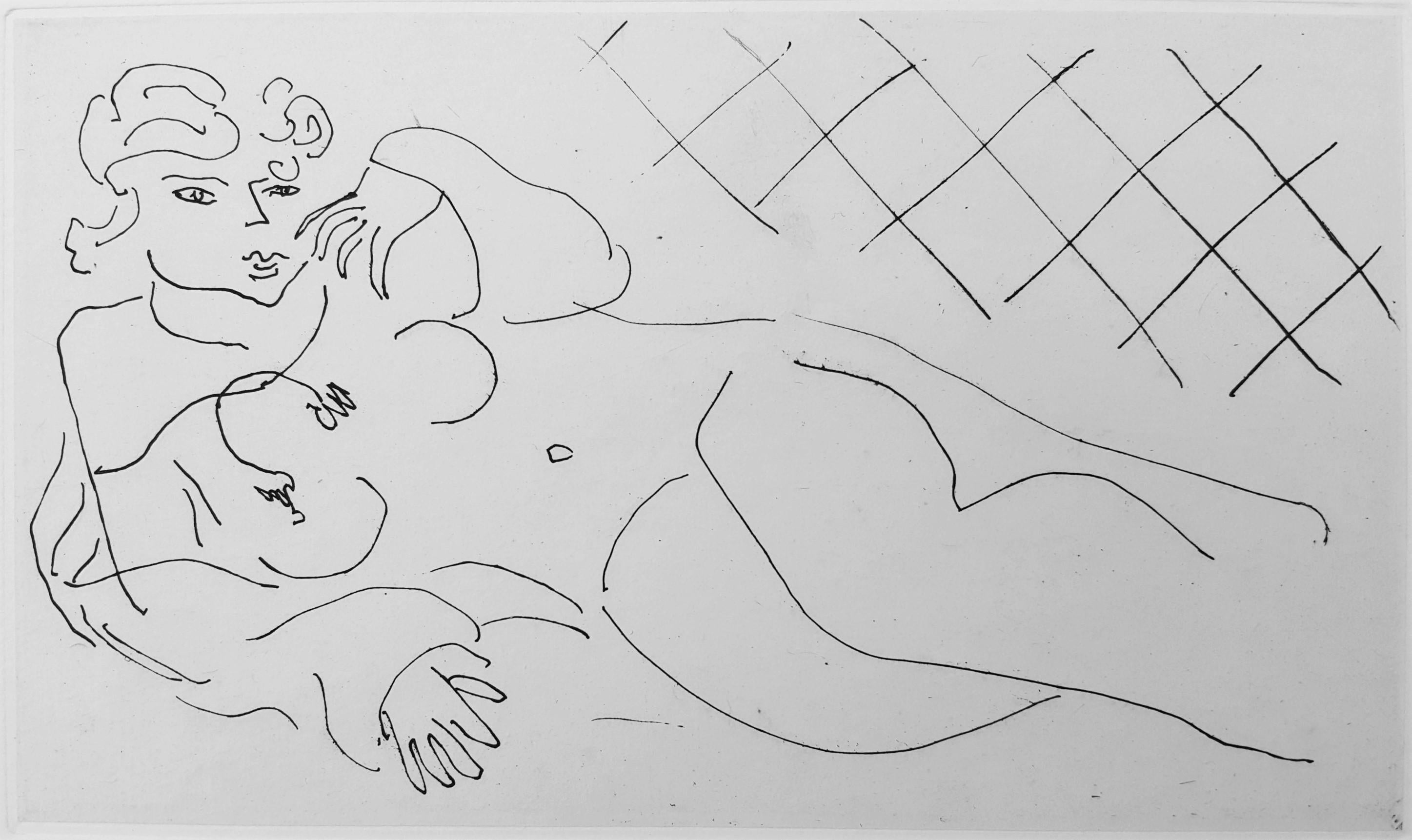André DerainErotic Female Nude - Etching from Le Satyricon
About the Item
- Creator:André Derain (1880-1954, French)
- Dimensions:Height: 17.5 in (44.45 cm)Width: 13.25 in (33.66 cm)
- Medium:
- Period:
- Condition:
- Gallery Location:Surfside, FL
- Reference Number:1stDibs: LU38210830152
André Derain
André Derain is best known as a leading figure of the avant-garde movement and — alongside Henri Matisse — a cofounder of Fauvism at the turn of the 20th century. Derain’s innovative use of expressive colors and simplified forms in his figurative paintings, landscapes and portraits continue to dazzle collectors and art enthusiasts everywhere.
Born in 1880 in Chatou, France, Derain began his formal art training at age 18 at the Académie Camillo, where he met Matisse and Maurice de Vlaminck. In 1905, Derain, Matisse and de Vlaminck exhibited their works at the Salon d’Automne in Paris, where critic Louis Vauxcelles used the word fauves (wild beasts) to describe the loosely connected collective of artists’ prioritization of audacious, vivid color in their energetic works, eventually leading to wide adoption of the term Fauvism.
In 1905 and 1906, Derain traveled to London, where he produced a series of Fauvist “form through color” paintings. These included The London Bridge, Charing Cross Bridge and A Corner of Hyde Park. After seeing a retrospective of Paul Gauguin’s work, Derain painted The Dance, a nude that is demonstrative of Gauguin’s influence in its bold, flat colors and in Derain’s depiction of primitive dancing figures.
In 1910, Derain destroyed many of his unsold works and began painting landscapes in the Cubist style of Paul Cézanne. He befriended Pablo Picasso and grew interested in African tribal art. After World War I, he focused on figurative and nude drawings and, in the early 1920s, abandoned Fauvism and Cubism altogether in favor of classical art. In 1930, the artist publicly condemned modernism, leading to his ostracization by the avant-garde community.
Derain was later honored with a retrospective of his works at the Kunsthalle in Bern, Switzerland. Additionally, the Exposition des Artistes Independants invited Derain to exhibit in 1937.
Derain’s wide range of styles — from Fauvism and Cubism to classicism and Postimpressionism — influenced many artists throughout his lifetime. Today, Derain’s work is held in the permanent collections of the Museum of Modern Art in New York, the Tate gallery in London, the Musée d’Orsay in Paris and the State Hermitage Museum in St. Petersburg.
On 1stDibs, discover original André Derain prints, drawings and paintings.
- ShippingRetrieving quote...Ships From: Surfside, FL
- Return PolicyA return for this item may be initiated within 3 days of delivery.
- Italian Surrealist Aquatint Etching Enrico Baj Pop Art Nude Mod Cherubs AngelsBy Enrico BajLocated in Surfside, FLEnrico Baj (1924-2003) Italian, limited edition print. Hand signed and numbered in pencil from limited edition of 100 Aquatint etching Image size: cm 39.5 x 29.5, sheet cm 53 x 39 ...Category
20th Century Surrealist Figurative Prints
MaterialsEtching, Aquatint
- Italian Surrealist Aquatint Etching Enrico Baj Pop Art Nude Mod Cherubs AngelsBy Enrico BajLocated in Surfside, FLEnrico Baj (1924-2003) Italian, limited edition print. Hand signed and numbered in pencil from limited edition of 100 Aquatint etching Image size: cm 39.5 x 29.5, sheet cm 53 x 39 ...Category
20th Century Surrealist Figurative Prints
MaterialsEtching, Aquatint
- Large Donald Saff Surrealist Pop Art Aquatint Etching Leopard Cheetah Big CatsBy Donald SaffLocated in Surfside, FLArtist: Donald Saff Title: Leopard or Cheetah, big cats in interior Year: 1980 Medium: Etching with Aquatint, Hand signed and numbered in pencil Edition: 150 30 in. x 22.5 in. (76.2 cm x 55.88 cm) Donald Jay Saff (born 12 December 1937) is an artist, art historian, educator, and lecturer, specializing in the fields of contemporary art in addition to American and English horology. Saff was born in Brooklyn, New York. Donald Saff began his undergraduate degree at Queens College, City University of New York, in 1955, initially envisioning a career as an electrical engineer. However, the following year Saff changed his major to art and learned printmaking, to graduate with a B.A. in 1959 and a M.A. in art history from Columbia University in 1960. In the years following, Saff was awarded a M.F.A. from Pratt Institute in 1962 and an Ed.D. in studio art and art history from Columbia University in 1964. In his early career, Saff studied with Robert Goldwater, Robert Branner, Louis Hechenbleikner, and Meyer Schapiro. Saff is primarily known for his work and collaboration with the leading artists of the late-twentieth century, including Robert Rauschenberg, Jim Dine, Roy Lichtenstein, James Rosenquist, Nancy Graves, Philip Pearlstein, and James Turrell. Saff's prolific career is the subject of Marilyn S. Kushner's book, Donald Saff: Art in Collaboration (2010). Saff began his teaching career at Queens College as a lecturer in Art History, Design, and Drawing, from 1961 to 1964. In 1965, Saff was appointed as an associate professor in the visual arts department of the University of South Florida in Tampa, Florida, and became professor and chairman of the visual arts department two years later. In 1971, Saff became the founding dean of the College of Fine Arts at U.S.F., and was awarded the rank of distinguished professor at the university in 1982. Saff was later named dean emeritus by USF in 1989, and distinguished professor emeritus in 1996. In 1999, Saff was awarded the honorary degree of Doctor of Fine Arts at U.S.F. He was appointed the Director of Capital Projects of the Solomon R. Guggenheim Foundation, New York, in 2001, followed by the appointment of Senior Curator of Prints and Drawings in 2002. In 1968, Saff founded Graphicstudio at U.S.F. through funding by a seed grant from the Florida Arts Council and community supporters; the following year, Philip Pearlstein was the first artist invited to Graphicstudio to collaborate with Saff and his team. Saff became Founding Dean of the College of Fine Arts at U.S.F. in 1971. Under Saff's directorship, Graphicstudio collaborated with artists such as James Rosenquist, Robert Rauschenberg, Richard Anuszkiewicz, Shusaku Arakawa, Jim Dine, Lee Friedlander, Nancy Graves, Ed Ruscha, and Roy Lichtenstein. The collection of Graphicstudio is archived in the National Gallery of Art in Washington, D.C. Graphicstudio was founded by Dr. Donald Saff as part of the renaissance in American printmaking in the 1960s, in the company of studios such as ULAE, Tamarind, and Gemini GEL. This renaissance brought artists involved in the Pop art movement, such as Robert Rauschenberg, James Rosenquist, and Jim Dine, together with a growing number of trained printmakers from around the world. After Saff retired from U.S.F., he continued to collaborate with these artists, as well as James Turrell, at Saff Tech Arts in Oxford, Maryland, which was established in 1991. While Saff and Rauschenberg were traveling in China, Rauschenberg conceived of the Rauschenberg Overseas Culture Interchange (ROCI) in 1982, which began in 1984 with Saff as the artistic director. Saff travelled to over twenty countries and met with poets and writers in order to decide which were the most appropriate venues for the show and prepare for Rauschenberg's visit and exhibition. In recent years, Saff has continued to lecture and write on art and the history and mechanics of nineteenth-century clocks; in particular, the work of Charles Fasoldt, in addition to the development of time distribution from the Harvard College Observatory, and the horological innovations of Richard F. Bond. He has lectured on Fasoldt for the Antiquarian Horological Association in Cincinnati, OH (2001), the National Association of Watch and Clock Collectors in Pittsburgh, PA, and Anheim, CA (2003), and at the 26th Annual Ward Francillon Time Symposium in Houston, TX (2004), among other venues. Saff continues to work with the Royal Observatory in Greenwich, collaborating with Jonathan Betts and Rory McEvoy, on the trials of Burgess Clock B. (See "Honors.") Exhibitions Saff's individual work spans across his career of collaborative art. As early as 1965, Saff produced Duino Elegies, a print suite that was published and exhibited by Martin Gordon Gallery in New York and at the Galleria Academia in Rome; it was acquired by the Library of Congress, the Brooklyn Museum, and Lessing Rosenwald. Saff also collaborated with printers Galli and Arduini in Urbino to create print suites Breezes (1969), exhibited and published by the Martin Gordon Gallery. Additionally, Saff collaborated with Galli on print suites Paradise Lost (1970) and Numbers (1972), the former printed in Tampa, FL, and exhibited at the Martin Gordon Gallery, the University of South Florida Gallery, the Toronto Art Gallery, and the Loch Haven Art Center, FL. Numbers was exhibited at Multiples Gallery, New York. In 1979, Saff produced print suite Fables that was published and exhibited by the Getler/Pall Gallery in New York, followed by the print suite Constellations (1980), which was also exhibited at the Tom Lutrell Gallery in San Francisco. In 1981, Saff had solo exhibitions of his artwork in the Galleria d'Arte Moderna in Udine, Italy, Youngstown State University, OH, the Leo Castelli Gallery, NY, and in "Recent Acquisitions" at The Museum of Modern Art, NY. Additionally, Saff had solo exhibitions at Dyansen Gallery, NY (1982), at I. Feldman Gallery, Sarasota (1983), and at Edison Community College, FL (1988). In 1989, the retrospective Donald Saff: Mixed Metaphors, 1956–1989 was held at the Tampa Museum of Art and traveled to the Virginia Beach Center for the Arts, followed by his solo exhibition Winged Metaphors: Sculpture and Prints by Donald Saff at the Barbara Gillman Gallery in Miami later that year. In 1997, Brenau University Galleries exhibits Poetics: The Work of Donald Saff in Gainesville, GA. The same year, the Tampa Museum of Art exhibited Donald Saff/Robert Rauschenberg: In Collaboration. Finally, the Academy Art Museum in Easton, MD, exhibited Donald Saff: Gravity and Constellations; Selected Works in 2006. Honors Saff was awarded a Teaching Fellowship at Queens College (1960), a Yaddo Fellowship, Saratoga Springs, NY (1963), and Fulbright Fellowship (1964) to Italy where he studied at Istituto Statale di Belle Arti. While in Urbino, Saff met lifelong friend and colleague Deli Sacilotto, with whom he would co-author Printmaking: History and Process (1978) and Screenprinting: History and Process (1979). He received the Governor's Award for the Arts from the State of Florida in 1973, and was awarded the Florida Endowment for the Arts Individual Artist Grant in 1980. In 1997, Saff was awarded the title "Printmaker Emeritus" by the 25th Southern Graphics Council Conference in Tampa, F.L. In 2002, he was appointed as Visiting Distinguished Professor of Rhode Island School of Design. In April 2015, Saff was awarded a certificate from the Guinness World Records for his work on completing the world's most accurate pendulum clock, "Clock B", which was started by Martin Burgess in 1975. The official title awarded by Guinness World Records, as "the most accurate mechanical clock with a pendulum...Category
1980s Pop Art Figurative Prints
MaterialsEtching, Aquatint
- Erotic Etching from Le SatyriconBy André DerainLocated in Surfside, FLThis lot is for one etching. --- Derain was born in 1880 in Chatou, Yvelines, Île-de-France, just outside Paris. In 1895 Derain began to study on his own, contrary to claims that meeting Vlaminck or Matisse began his efforts to paint, and occasionally went to the countryside with an old friend of Cézanne's, Father Jacomin along with his two sons. In 1898, while studying to be an engineer at the Académie Camillo, he attended painting classes under Eugène Carrière, and there met Matisse. In 1900, he met and shared a studio with Maurice de Vlaminck and together they began to paint scenes in the neighbourhood, but this was interrupted by military service at Commercy from September 1901 to 1904. Following his release from service, Matisse persuaded Derain's parents to allow him to abandon his engineering career and devote himself solely to painting; subsequently Derain attended the Académie Julian. At about this time Derain's work began overtly reflecting his study of the Old Masters. The role of color was reduced and forms became austere; the years 1911–1914 are sometimes referred to as his gothic period. In 1914 he was mobilized for military service in World War I and until his release in 1919 he would have little time for painting, although in 1916 he provided a set of illustrations for André Breton's first book, Mont de Piete. After the war, Derain won new acclaim as a leader of the renewed classicism then ascendant. With the wildness of his Fauve years far behind, he was admired as an upholder of tradition. In 1919 he designed the ballet La Boutique fantasque for Diaghilev, leader of the Ballets Russes. A major success, it would lead to his creating many ballet designs. The 1920s marked the height of his success, as he was awarded the Carnegie Prize in 1928 for his "Still-life with Dead Game" and began to exhibit extensively abroad—in London, Berlin, Frankfurt, Düsseldorf, New York City and Cincinnati, Ohio. During the German occupation of France in World War II, Derain lived primarily in Paris and was much courted by the Germans because he represented the prestige of French culture. Derain accepted an invitation to make an official visit to Germany in 1941, and traveled with other French artists to Berlin to attend a Nazi exhibition of an officially endorsed artist, Arno Breker. Derain's presence in Germany was used effectively by Nazi propaganda...Category
20th Century Nude Prints
MaterialsEtching
- German Surrealist Hans Bellmer Etching Engraving Print Cecile Reims SurrealismBy Hans BellmerLocated in Surfside, FLAfter Hans Bellmer (German, 1902-1975) Surrealist engraving, etching after drawings from a 1942 notebook, engraved in 1974-75 by Cecile Reims Printed by L'Atelier de Chalcographie ...Category
20th Century Abstract Prints
MaterialsEtching
- German Surrealist Hans Bellmer Etching Engraving Print Cecile Reims SurrealismBy Hans BellmerLocated in Surfside, FLAfter Hans Bellmer (German, 1902-1975) Surrealist engraving, etching after drawings from a 1942 notebook, engraved in 1974-75 by Cecile Reims Printed by L'Atelier de Chalcographie ...Category
20th Century Abstract Prints
MaterialsEtching
- Woman Nude from the back - Original Etching by Giacomo Porzano - 1972By Giacomo PorzanoLocated in Roma, ITLimited edition of 66 prints, 50 in arab numbers and 16 in roman numbers, all hand signed and numbered. Excellent condition.Category
1970s Contemporary Figurative Prints
MaterialsEtching
- The Talisman (so called Dukatenscheisser) - The philosopher's stone -By Carl PlückebaumLocated in Berlin, DECarl Maria Plückebaum (1880 Düsseldorf - 1952 ibid.), Der Talismann (sog. Dukatenscheisser), partly colored etching, 11.5 x 8.5 cm (plate size), 26.5 x 20 cm (sheet size), signed by hand below the image on the right "C. Plückebaum" and inscribed by hand at lower left "Der Talismann". - left and right side of the sheet with browned stripes, otherwise good copy - The philosopher's stone - About the artist Here, Carl Plückebaum gives free rein to his anti-academic impulses and turns the subtle humor of his pictures into crudeness. Following Adrian Ostade's peasants as they go about their needy business, we see a cowardly fellow in a squatting position. His excrement, however, is not the organic remains of digestion, but - like the golden donkey in the Grimm fairy tale - ducats. However, they appear more brown than golden, which is emphasized by the discreet hand-coloring of the picture. The unattractive accumulation is countered by the blossoms decorating the crouching man's hat. Totally absorbed in his action, his activity is evident in the strained expression on his face, giving Plückebaum a whole new verisimilitude to the concept of naturalism. The title "The Talisman" then turns naturalism back to the miraculous, formulating in a humorous way that these legacies are also a "miracle of nature". About the artist Coming from a poor background, Carl Plückebaum, who had a walking disability and was of short stature, initially worked as a church restorer. He also took private drawing lessons. In 1901 he won the first prize of the Düsseldorf Museum of Decorative Arts, which enabled him to finance his studies at the Düsseldorf Academy. There he was a pupil of Eduard von Gebhardt and Peter Janssen the Elder, but began to doubt the academic teaching. In 1906 he took part in a group exhibition at the Städtische Kunsthalle Düsseldorf, which violated the academy's statutes and led to his dismissal. However, the extraordinary success with the public confirmed him as an artist and provided him with the financial means for a study trip to Italy. Enchanted by Florence, he retired to the Franciscan monastery of Fisole, where he worked as a fresco painter. Back in Düsseldorf, he turned increasingly to children's and animal drawings, and in 1907 he was a founding member of the Niederrhein Secessionist Artists' Group. In 1910 he travelled to Italy again, accompanied by his painter friends Walter Ophey and Carl Schmitz-Pleis, visiting Rome and Naples in particular. He then stayed in Munich to study the Old Masters at the Pinakothek. It was in the artistic circles of Schwabing that he met his future wife, the painter Meta Weber. In Düsseldorf, Carl and Meta Plückebaum...Category
Early 20th Century Realist Figurative Prints
MaterialsEtching
- The TwoBy Anders ZornLocated in Tallinn, EEAnders Zorn (Utmeland/Dalarne, 1860 - Mora/Sweden, 1920) The Two", 1916 Signed in pencil lower right and monogrammed and dated in the plate. Etching on laid paper. 35,5 x 23 cm; 20,2...Category
1910s Figurative Prints
MaterialsLaid Paper, Etching
- Three courtroom scenes original signed etchings by French artist Gaston HoffmanBy Gaston HoffmannLocated in Paonia, COFrench artist Gaston Hoffman. Hoffman ( 1883 – 1960 ) was a painter, decorator, cartoonist and illustrator well known for his satirical French courtroom scenes. There are three related scenes here. The first one is titled "and after my little girl " In this image we see a young woman pleading before the court much to the horror (and delight ) of the judges. What could she be confessing to get such a reaction? The next in the sequence is titled " Dernier Argument " A most outrageous scene in the French Court ( ou la la the French ) . The third in the sequence is " Evacuez la Salle " everybody out of the courtroom " All in good condition coming to you straight from the publisher Sidney Z...Category
20th Century Other Art Style Figurative Prints
MaterialsEtching
- Nude of Woman - Etching by Edouard Chimot - 1930sBy Édouard ChimotLocated in Roma, ITNude of Woman is an Etching realized by Edouard Chimot in 1930s. The very beautiful artwork is in good condition. No Signature. Represents a nude young lady. Édouard Chimot (26 November 1880 – 7 June 1959) was a French artist, illustrator and editor whose career reached its peak in the 1920s in Paris, through the publication of fine quality art-printed books. As artist his own work occupies a characteristic place, but as editor also his role was extremely important...Category
1920s Modern Figurative Prints
MaterialsEtching
- Figure allongée devant un carrelage (Figure Lying in front of a Tiled Floor)By Henri MatisseLocated in Saint Augustine, FLArtist: Henri Matisse (French, 1869-1954) Title: "Figure allongée devant un carrelage (Figure Lying in front of a Tiled Floor)" *Signed and numbered by Matisse in pencil lower right ...Category
1920s Modern Nude Prints
MaterialsEtching, Intaglio






